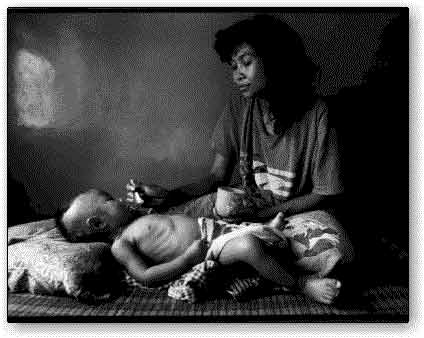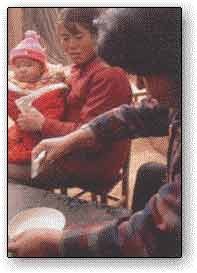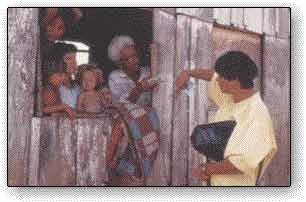Diarrhoeal disease
is the greatest single killer of children in the developing world and often the
chief cause of childhood malnutrition.
Every child under 5 years of age in the developing
world suffers from, on average, 2-3 episodes of diarrhoea a year, and in the first 2 years
of life as many as 20 per 1000 may die from diarrhoea.
This means that the acute diarrhoeal diseases cause
an estimated 750 million to 1 billion episodes of illness and some 3-4 million
deaths each year in under-five-year-olds.
But that is not all: these repeated attacks of
diarrhoea are a major cause of malnutrition and faltering height and weight gain; and, in
turn, undernourished children suffer more severe and often more frequent attacks of
diarrhoea. |
 |
Thus, a vicious cycle of diarrhoea - malnutrition -
diarrhoea is established which can have long-lasting effects on the quality of life of the
child. In addition, diarrhoea cases in many areas of the world still account for 30% or
more of admissions to children's hospitals or wards where they receive, unnecessarily,
expensive intravenous fluids, antibiotics, and drugs, thereby creating a heavy burden for
limited national health budgets. Nutritional Status
In addition to causing acute dehydration, diarrhoea impairs nutritional
status through the cumulative effect of repeated episodes. This takes place in a number of
ways: the child loses its appetite and eats less; parents may withhold food from the sick
child; nutrients are poorly absorbed by the intestines during and after the diarrhoea
episode; and body tissues are broken down metabolically. With repeated diarrhoea attacks
and ever-worsening nutritional status, the child becomes increasingly susceptible to other
acute infections. Thus, diarrhoea and associated malnutrition contribute to many deaths
that are attributed to other causes. Dangers
of Fluid Loss
Fluid loss from diarrhoea up to 5 percent of body weight produces thirst
but generally no other symptoms.
Greater loss causes
- a weak, rapid pulse
- a loss of skin elasticity
- low blood pressure
- reduced urinary output
- severe thirst.
With more than 10 percent loss
- shock may set in - stupor occurs
- kidney function is disrupted
- peripheral blood vessels collapse
- acids build up (metabolic acidosis)
- death follows.
Diarrhoeal infections inhibit the body's ability to absorb salts and
water. So fluid is lost faster than it can be replaced - leading to dehydration. Dangers from Diarrhoea
The two main dangers from diarrhoea are Death and Malnutrition. Death from acute diarrhoea is usually caused by loss of a large amount
of water and salts from the body. This is called dehydration. Early features are difficult
to detect but include dryness of month and thirst. The signs of dehydration include:
sunken fontanelle (in infants); fast, weak pulse; breathing faster than normal; loss of
skin elasticity; sunken, dry eyes and reduced amount of urine. Rehydration is the
correction of dehydration. Malnutrition from Diarrhoea
Malnutrition from diarrhoea is caused by the loss of food nutrients from
the body. It is important to stress here the relationship of diarrhoea with
malnutrition. Diarrhoea is common in malnourished children and malnutrition results from
diarrhoea. Until recently, these diseases were regarded as a necessary evil to be
endured for decades to come until socio-economic development reached the level it has
attained today in the industrialized nations, where these diseases are no longer a major
public health problem. However, the international community's commitment to primary health
care and significant new knowledge acquired in the last decade in the treatment of acute
diarrhoea have provided a solid basis for an immediate global attack on the problem. The
most important of the new developments is Oral Rehydration Therapy (ORT). ORT is Cheap
 |
ORT is the cheap, simple and effective way to
treat dehydration caused by diarrhoea. Many of the millions of children who die every year in
developing countries from diarrhoea could be saved if they were given ORT promptly.
This includes giving extra fluids at home such as tea, soups, rice water and fruit juices
to prevent dehydration, and the use of Oral Rehydration salts (ORS) solutions to treat
dehydration.
|
Make up with clean water, the ORS drink contains the main elements that are
lost from the body during diarrhoea. It is effective in treating dehydration resulting
from all types of acute diarrhoeal diseases. ORT is based on the discovery that glucose greatly increases the
patient's capacity to absorb salts and water. Drinking a solution of salts; glucose and
water can therefore, prevent dehydration. Until the discovery of ORT, the only known method of treating
dehydration, caused by diarrhoea, was by intravenous therapy administered by qualified
medics in modern clinics or a hospital setting. Now, dehydration can be prevented by a
simple solution of salt, sugar and water administered orally by parents in the child's own
home. Acute diarrhoea normally only lasts a few days. ORT does not stop the
diarrhoea, but it replaces the lost fluids and essential salts thus preventing or treating
dehydration and reducing the danger. ORT alone is an effective treatment for 90 - 95 per
cent of patients suffering from acute watery diarrhoea, regardless of cause. This makes
intravenous drip therapy unnecessary in all but the most severe cases. ORT is the giving of fluid by mouth to prevent and/or
correct the dehydration that is a result of diarrhoea. As soon as diarrhoea begins,
treatment using home remedies to prevent dehydration must be started. If adults or
children have not been given extra drinks, or if in spite of this dehydration does occur,
they must be treated with a special drink made with oral rehydration salts (ORS). ORS Formula
| Reduced osmolarity ORS |
grams/litre |
Reduced osmolarity ORS |
mmol/litre |
| Sodium chloride |
2.6 |
Sodium |
75 |
| Anhydrous Glucose |
13.5 |
Anhydrous Glucose |
75 |
| Potassium chloride |
1.5 |
Chloride |
65 |
| Trisodium citrate, dihydrate |
2.9 |
Potassium |
20 |
| |
|
Citrate |
10 |
| |
|
Total Osmolarity |
245 |
|
 |
The presence of potassium in ORS is particularly important for the treatment losses in
diarrhoea are relatively high. Studies have shown that undernourished children who have
suffered repeated bouts of diarrhoea are especially likely to develop a blood level of
potassium below normal if the potassium below normal if the potassium is not replaced
during rehydration.
 |
The citrate in ORS is needed for the treatment of acidosis, which occurs
frequently with dehydration. Glucose is included in the solution principally to help the absorption
of sodium and not as a source of energy. These packets have been distributed and used in many parts of the
world, especially by UNICEF.
|
Pre-packaged oral rehydration salts (ORS) cost only about U.S.10 cents. But making the
packets available to every household is not always feasible. Do-It-Yourself
So many ORT campaigns are concentrating on the teaching mothers to
forestall dehydration by using household remedies - usually sugar and salt solutions. Using either the U.S.10 cent sachet of salts formula or a homemade
mixture of salt and sugar in the right proportions, parents themselves can make an
effective oral rehydration solution. And it is this do-it-yourself element which could
make the new treatment available to the majority of the world's children, despite the fact
that most have no access to modern health care. Over the next five years, ORT could spread
to half the world's families. At that point, it will save the lives of some two million
children a year. This type of therapy can be delivered by village health workers and
practiced in the home by mothers with some guidance, and thus, is a technology highly
suited for the primary health care approach. Moreover, when given along with advice on
proper feeding practices, ORT has been found to contribute to better weight gain and thus
to reduce the ill effects of diarrhoea on nutritional status. ORT is safe and can be used to treat anyone suffering from diarrhoea,
without having to make a detailed diagnosis before the solution is given. Adults need
rehydration treatment as much as children, although children must always be treated
immediately because they become dehydrated more quickly.
Many countries now have diarrhoeal disease control programmes,
but ORT is still not nearly as widely used as it should be and more effective information,
dissemination and promotion of ORT is necessary.
The prevention of diarrhoea depends upon improvements in water supply,
sanitation, and hygiene. But in the meantime, the majority of deaths from diarrhoeal
dehydration can be cheaply prevented by oral rehydration therapy (ORT).
 |
 |
|